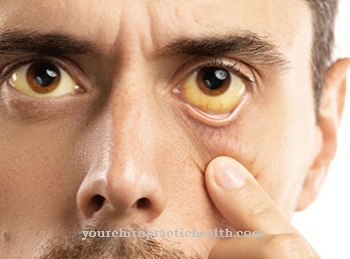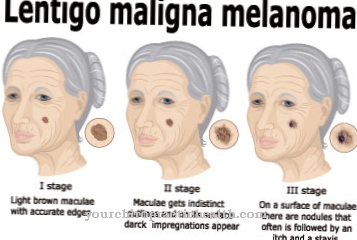As Skin cancer one describes various, mostly malignant, tumors of the skin. The best known forms are melanoma (black skin cancer) and actinic keratosis, basalioma and spinalioma (light skin cancer). Skin cancer is usually caused by severe sunburn in a person's youth. But other skin stresses and carcinogenic substances can also trigger skin cancer.
What is skin cancer?

Skin cancer is the term used to describe all malignant tumors that affect the largest human organ, the skin. A distinction is made between black and white skin cancer. These two types differ not only in their pigmentation, but also in their shape, as well as the location of their appearance.
There are three types of skin cancer: basalioma, spinalioma and actinic keratosis. Light skin cancer is more common in older people, preferably on the face. Often this is removed surgically; metastasis is far less common in light skin cancer than in black skin cancer.
causes
The main cause of skin cancer is generally too long or too strong exposure to the sun. Black skin cancer is particularly prone to sunburn when you were a child.
People with light skin and blond or reddish hair are significantly more likely to develop skin cancer.
Furthermore, skin cancer can develop when one is exposed to carcinogenic sources. This can be asbestos as well as tar or radioactive substances. Furthermore, skin cancer can be genetic. Those who have the appropriate traits in their genome are often more at risk.
Symptoms, ailments & signs

The tricky thing about skin cancer is that it remains without specific symptoms for a long time. Very itchy or bleeding birthmarks are always a warning sign. A dermatologist should clarify this immediately, especially in the event of sudden bleeding. Possible signs of skin cancer can best be recognized in the early stages, if one regularly and systematically observes the moles oneself.
The ABCDE rule can give the layman a first clue. Asymmetrical marks can be suspicious as well as those that are not clearly delimited. Taken in isolation, neither of these features are clear indications of skin cancer and, accordingly, no reason for panic if something becomes apparent during self-observation. However, fuzzy, very asymmetrical birthmarks should be presented to a specialist as soon as possible.
The same applies to an unclear color. Most of the times are of an even shade. The first sign of skin cancer in many patients is that the mark has changed in color. The diameter can also provide clues.
Birthmarks that are larger than five millimeters should be checked just as regularly as those that suddenly appear larger. The aspect of grandeur can also be a symptom of cancer. Most healthy marks are even and not raised in the skin. If one gets up suddenly, it can be a sign of a malicious change.
course
Untreated black skin cancer almost always results in death. A dermatologist should therefore always be consulted immediately in the case of skin disorders and strange moles or moles. But even if there is no abnormality, it is advisable to have your skin examined for possible tumors once a year.
The earlier skin cancer is detected, the higher the chances of recovery. If the skin cancer was diagnosed late, it is quite likely that it has metastasized throughout the body. Then the chance of survival with skin cancer is unfortunately very low.
Complications
Various complications can arise in connection with skin cancer. First of all, there is a risk that the cancer will metastasize. If the tumors spread to the internal organs, serious secondary diseases and functional failures can occur, which must be treated independently. The complications depend on the stage of the cancer.
In the second stage, lymph nodes become infected, usually associated with exhaustion, weight loss and other complaints. Skin cancer in the third stage affects the liver, kidneys, lungs and brain and is associated with nausea, vomiting, gait disorders and fatigue, among other things. In the further course of the disease, the affected organs usually fail to function and ultimately lead to the death of the patient. Complications can also arise in treating skin cancer.
During an operation, there is a risk that surrounding structures will be damaged. Depending on the location of the finding, this can result in significant functional restrictions and cosmetic problems. If nerves are injured, numbness and paralysis can occur. It can also lead to bleeding, bruising, wound healing disorders and excessive scarring. The prescribed drugs and alternative therapy methods can cause further side effects and physical and psychological complaints.
When should you go to the doctor?
Visiting a specialist early on improves the chances of recovery from skin cancer considerably. In this respect, every area of skin that appears changed should be shown to a dermatologist very quickly. Changes that make it necessary to go to the dermatologist can, for example, increase the size or change the color of individual birthmarks. Even new times that are visually different from others should be presented to a specialist if there is the slightest doubt.
In principle, a monthly self-examination of the skin should take place. Here you should pay attention to the size, shape, elevation and aspects such as itching of birthmarks. Since the earliest possible detection of a melanoma is very important in terms of removal and healing prospects, any change that appears conspicuous and causes concern must be shown to the dermatologist quickly.
Within a few minutes, the doctor can make an initial assessment of whether further examinations are indicated or whether the phenomenon is harmless. Melanoma can, depending on the part of the body, grow undetected for a long time. Symptoms such as injuries that do not heal well, bleeding from birthmarks, and painful areas of skin that look different, often only appear at an advanced stage of skin cancer. Bleeding from birthmarks, in particular, should be examined immediately by a specialist.
Doctors & therapists in your area
Treatment & Therapy
The diagnosis of skin cancer is usually made quickly and clearly by a dermatologist, as this is already present when the affected areas of the skin are examined. Extra tissue removal provides additional security, but in most cases it is not necessary. The treatment of skin cancer depends on the stage in which the disease is.
The doctor will usually remove the affected area of skin in a surgical procedure. Nowadays this is mostly done under local anesthesia. However, if the cancer is more advanced, radiation or chemotherapy is used. Immunotherapy has also achieved good results against this disease. The earlier it is detected, the better the chances of recovery from so-called black skin cancer.
Regular follow-up checks are essential after the melanoma has been removed. However, if metastases have already formed in the advanced stage, the chances of survival are usually only low. White or light skin cancer usually has a better chance of recovery than black skin cancer.
Outlook & forecast
The prognosis of skin cancer depends on the progression of the disease and the time of the start of treatment. With early detection, skin cancer is in most cases completely curable thanks to medical advances. The further the cancer cells have spread in the organism, the worse the chances of recovery.
If the skin cancer is confined to a local area on the body, there is a good chance of recovery. The affected region is removed and a subsequent cancer therapy. After successful therapy, the patient should take part in check-ups at regular intervals and protect himself adequately from direct sunlight.
If several areas of skin cancer have already formed on the body, the chances of recovery are immensely reduced. If metastases develop in different parts of the body, the prognosis for the patient is poor. If the skin cancer has already spread to the dermis, there is a risk that it will multiply via the blood and lymph vessels throughout the body.
Despite a healed skin cancer, the disease can break out again in the course of life. In these cases, early detection is also vital, as there is a good prognosis for a recurrence only if treated quickly.
prevention
To prevent skin cancer, if possible, do not stay too long in the sun. It is of course important to always protect yourself adequately - sun creams are available in all pharmacies and drug stores. Small children in particular should be given special protection - a hat is the top priority here.
Visiting solariums has recently become more and more popular, because after all, someone who is tanned is considered beautiful. But it is precisely this artificially generated sunlight that is extremely harmful to the body. It is not for nothing that the number of skin cancers has risen significantly in recent years. In order to prevent this disease or to detect skin cancer in good time, you should check your body regularly. Especially people with many moles should examine them for any changes.
If these moles become larger or change their structure, a dermatologist should be consulted as a precaution. The so-called ABCDE rule helps here (asymmetry, limitation, color, diameter, elevation should be considered according to this - this is how harmless moles can be easily distinguished from the dangerous melanomas of black skin cancer).
Aftercare
Careful follow-up care is essential for patients with skin cancer. Even after successful therapy, those affected are at high risk of recurrence. Since the majority of recurrences occur within the first five years, follow-up examinations are particularly regular during this period. The intervals and scope of these examinations are individually dependent on the type and severity of the tumor removed.
In the case of melanoma, frequent follow-up examinations are advisable as metastases are common. For this reason, a close medical check-up (every three to six months) is recommended for the first five years. Follow-up care should be maintained for life.
Some forms of skin cancer have a relatively high tendency to recur. Those affected should have their entire skin regularly dermatologically examined following an operation or alternative therapy. If there is no new tumor formation in the first year after removal of the tumor, annual follow-up checks are sufficient.
Through careful follow-up care, pathological changes in the skin or secondary affected organs can be detected in good time. Regular self-examination is also an important part of follow-up care. In future, those affected should avoid strong sunlight and ensure adequate UV protection.
You can do that yourself
Skin cancer is a serious disease that can be treated well if detected early. The physical and mental stress associated with a diagnosis of skin cancer can be reduced through various self-help measures.
First of all, rest and bed rest help against physical strain, always depending on the individual condition of the patient. The psychological stress can be counteracted by therapeutic measures. The doctor may recommend visiting a self-help group or suggesting physical activity to the person concerned. Measures such as yoga or physiotherapy in particular reduce the stress level without overloading the body during the illness.
Patients with "black" skin cancer may also need to change their diet. Here, individual nutritional advice from specialists can be useful. In less severe cases, it is sufficient to ensure a healthy and balanced diet with all the necessary vitamins and minerals.
The menu should be supplemented primarily with antioxidant foods with omega-3 fatty acids. For example, nuts, various types of fish, cauliflower, figs, oranges and linseed oil are said to have an effect that destroys cancer-causing substances and inhibits cancer cells. Those affected should always discuss with the responsible doctor which measures are to be taken in detail.



























